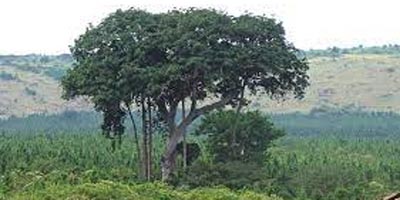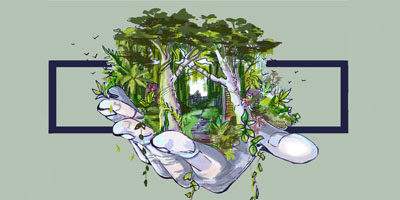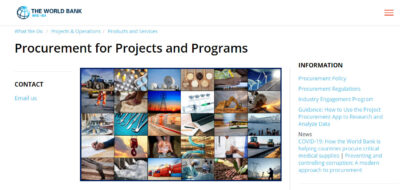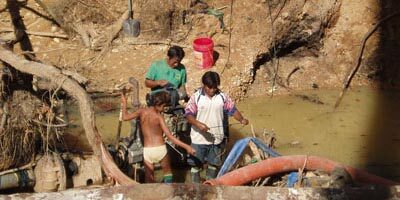How a project claiming sustainable development and climate change mitigation brought human rights abuse and environmental destruction.
What connects Ugandan farmers, a Norwegian company, Sweden and Caribbean Pine trees? A questionable project that claims to fight climate change, but instead drew attention for human rights abuse and environmental deterioration.
In the Central Forest Reserve of Kachung, Uganda, a Norwegian company called Green Resources leases around 2,500 hectares to grow pine trees. The Swedish Energy Agency (SEA) pays Green Resources for the carbon credits the trees generate, in a deal worth over $4,000,000. Sweden’s low carbon footprint relies on its domestic efforts but also on ninety-six projects it finances in developing countries as part of the UN’s Clean Development Mechanism.
The Ugandan government, in order to enable the project, had violently evicted local people prior to the arrival of Green Resources. These people, who mainly relied on subsistence agriculture, lived near the Kachung forest for generations until they were evicted by the National Forestry Authority (NFA).
The SEA and Green Resources were made aware of the evictions by an independent due diligence audit, but the SEA ignored the section of the report on the socioeconomic risks and wrote on its website that “a new healthy forest is emerging where there previously was only unused bush land.”
Supporters of the plantation assert that they are contributing to sustainable development and climate change mitigation, with endorsement by the UN.
For its part, Green Resources denies the charges of social and environmental harm, committing on its website to protect the environment and to “help develop local communities where it operates.” The project was also accredited by three well known bodies: the Forest Stewardship Council (FSC), the UN Clean Development Mechanism (CDM), and the Climate, Community, and Biodiversity Alliance (CCBA), all of which are supposed to guarantee the social and environmental benefits of such projects.
Due diligence audits were also performed by other external actors, with diverging conclusions about any positive outcomes of the project and the extent to which it came with or without significant social and environmental costs.
These differing conclusions by independent monitoring audits indicate issues with the oversight of the project, but certain facts can be ascertained nonetheless.
– Longer version of video (4 minutes)
I spoke with three experts to analyze this complex situation:
– Fréderic Mousseau, Policy Director at The Oakland Institute, an independent policy think tank in California The institute, after being contacted by local NGOs, has visited the plantations and issued three reports since 2014.
– David Kureeba, Coordinator Forests and Biodiversity at the National Association of Professional Environmentalists, Uganda. He has monitored the Kachung project and met with the local communities many times.
– Klara Fischer, Researcher in rural development, Swedish University of Agricultural Science. Involved in this topic since 2013, she has conducted interviews with all key actors in the Kachung project: SEA, GR, the NFA and local communities.
- Green Resources’ CEO declined an interview request, saying that under normal circumstances they would have agreed but that they have reached out to one of their strong critics seeking a direct dialogue rather than respond to various publications and online channels.
- A spokesperson for Norfund, the major shareholder of Green Resources, declined saying that the company would be better placed to answer questions, and did not respond to follow-up messages.
- The Swedish Energy Agency declined with no reason given.
- The National Forestry Authority did not respond to the request for an interview.
- Consultants involved in the accreditation bodies’ reports could not participate due to confidentiality agreements and professional conduct requirements.
The impact on local communities
After a Swedish investigation television program, Kalla fakta (Cold Facts), revealed issues with the plantation in 2015, the SEA commissioned another audit of the project. It noted various problems related to human rights and land rights conflicts which were not included in the various certification reports. As a result, the SEA froze its payments in 2015, saying, “Villagers were [being] deprived of vital resources and experienced threats and violence, and there is a lack of clarity regarding ownership in the reserve.” The SEA promised the unfreezing of the payments on condition of a set of actions geared towards local populations’ livelihoods.
The 2017 monitoring audit still raised awareness on the food insecurity issue faced by local communities that Green Resources failed to address.
For this article, I spoke with Klara Fischer, a Swedish academic expert in rural development. She said that interviews she conducted with local residents in 2014 showed that the situation had not changed much since the publication of the 2011 report.
“I think for the people around the plantation the impacts have been mainly negative,” she said. “Most of them were encouraged by the government to take this state-owned land where the plantations are. Now they don’t have access to the land that they used for agriculture and grazing. Even the few people who had been employed locally have gotten low paid and seasonal jobs. They said that it was better when they had their land than this job.
“Green Resources tried to mitigate this by digging wells and giving out tree seedlings, but only people with land could benefit from seedlings.”
David Kureeba, a Ugandan environmentalist, agrees. “If you look at people living around the forest, their livelihoods didn’t improve for sure. The land on which the communities are is very small and they don’t grow as much food as they used to.”
The impact on the local environment
“This is business as usual; it has nothing to do with conservation” – D. Kureeba
The human rights and environmental issues are intertwined. In addition to affecting the living conditions of local communities, Fischer says that there is evidence that the tree monoculture has also largely affected the local ecosystem, “The data is 100% clear,” she says. “There has been a lot of biodiversity reduction as a result of the plantation.”
“Biodiversity doesn’t mean planting of one species,” Kureeba says. “When you talk about biodiversity you are talking about different lives that exist in an area: bugs, microbes, wildlife and different species of animals. But if you introduce pine and eucalyptus which you harvest after fifteen years, where is the life?
“The fast-growing trees tend to consume much more water than indigenous species. So, water levels have gone down. I don’t believe that pine trees and eucalyptus can do good, given that the trees are cut down for making charcoal or timber.”
Green Resources also uses different chemicals such as glyphosate to do ground clearance within its plantations. The Oakland Institute, which has published three reports on the situation since 2014, reported that a number of villagers described the deaths of animals such as cattle, honey bees and ants after exposure to agrochemicals used in the plantation.
Is it possible that the situation is being misreported?
The validity of the certification bodies and the overall certification system has been questioned. For instance, the FSC label is so controversial that important members such as Greenpeace or Friends of the Earth have left it. A founder member, Simon Counsell, left with others to launch FSC-Watch, which documents FSC’s failures. According to him, most of what it is certifying is a travesty of the notion of forests.
“It is misleading to call it a forest,” Fischer says. “The story from Green Resources’ perspective is that they are planting a forest on a degraded environment so they are improving the local environment, local people’s lives and capturing carbon. Another way of seeing it is that they are taking away all the local biodiversity and ground clearing with Roundup. They plant two species of trees and harvest them after twenty years, and people cannot use the land to farm anymore.”
The due diligence audits are performed by independent consultancy firms but this does not guarantee complete objectivity, Kureeba says. “Often these organizations work with the company that gives them transport and they take them to leaders that are pro-project, so they never make an independent assessment.”
Counsell also identified concerns with the independence of audits in a 2008 Mongabay article. “Companies wanting to get certified directly contract with and pay the certification companies to assess them and issue certificates. The certifiers have a vested economic interest to issue certificates, even when their ‘clients’ do not deserve them. Because the accredited FSC certifiers are all competing with each other for business, there is, I believe, a ‘race to the bottom’ of certification standards going on, with the certifiers all trying to be more ‘generous’ than their competitors to capture more certification business.”
According to him, FSC “needs to break the direct economic link between the certifiers and the loggers that want to get certified.” to gain back its credibility.
Who is responsible?
Green Resources
“Green Resources is not an evil company but the system makes it possible. So we need to try to change the system.” – K. Fischer
The company didn’t directly evict farmers, yet it did invest in land from which subsistence farmers have been evicted, and continue to be evicted, by local authorities. The three experts interviewed also agreed that Green Resources misreports the reality when it asserts that it is contributing to sustainable development and environmental preservation.
“It is difficult to make investments in non-democratic states” Fischer says. Yet the choice to deal with such states, often motivated by particularly high margins, implies greater responsibility of corporations in terms of compensation and community development.
In its 2014 report on the situation, The Oakland Institute identified that this responsibility includes the international community. “Given the role of many governments in facilitating land grabs in their own countries, international bodies and agencies involved in carbon markets must set up higher standards for the recognition of common and customary land rights than just the legality of contracts and land leases.”
Green Resources’ defense is largely based on the legality of its activity and the blaming of the illegality of local communities’ “encroachments”. For instance, in a Thomson Reuters Foundation video, a representative of the company justified not providing support to a village by describing it as an “illegal settlement”.
The company’s website repeats this legalistic argument. “Farming and livestock grazing in a Forest Reserve are illegal according to Ugandan law, the same way that cultivating land in a Swedish nature reserve would also be illegal”.
If Green Resources is a business benefiting from the system and the legal framework in which it is operating, other actors might have an even greater responsibility.
The Swedish Energy Agency & Norfund
The Swedish Energy Agency (SEA) and Norfund join Green Resources in using the legality discourse to deny criticism. However, a strict legality approach is not enough Mousseau says. “Legality is not everything, these agencies must respect other sets of norms and standards implied by their mandates, their commitments to the taxpayers in their country, and the IFC (International Finance Corporation) principles that they falsely claim to respect.”
However, it is important to mention that Klara Fischer’s interviews with GR and SEA employees revealed how many of them were sincerely convinced that they were improving people’s lives and having a positive impact on the environment. The employees are mostly business people and engineers, not trained to deal with human rights and sustainable development issues.
Why Norfund, a development fund, failed to ensure that this project would conform with principles of sustainable development is another question.
The Ugandan state
This project couldn’t be possible without the permission of the Ugandan state, which accepted the sacrifice of local communities’ livelihoods and the forest’s biodiversity to attract foreign investment.
The government promised 500 hectares for the community but the land was not well demarcated and GR started planting trees on it. Since then, they didn’t resolve the situation and many people remain without land titles.
Uganda could have ensured that Green Resources’ community programs and preservation actions would indeed be beneficial when it accepted the project. Fischer and Hadju, in a 2017 article in the Journal of Environmental Policy and Planning, state that “the Ugandan government had to approve the CDM investment and was responsible for ensuring that the claims made about sustainable development contributions by GR were sufficient and in line with national requirements on sustainable development. However, no ‘sustainable development’ demands were placed on GR”.
The accreditation bodies
The Clean Development Mechanism (CDM) is supposed to contain safeguards and cross-checks to ensure that certified projects are not subject to misrepresentation and do not result in outcomes contrary to the initial goals. So, the independent actors that certified and monitored this project are responsible for not fulfilling their mission as watchdogs. There is no clear answer as to how and why these agencies failed to see the real nature of this project. At best they lacked critical thinking, at worse they voluntarily didn’t report the facts that would go against their clients’ interests.
Towards a systematic responsibility
The Clean Development Mechanism (CDM): a flawed system
Green Resources’ plantations in Uganda are not an isolated case. Other similar situations have been denounced in Uganda as well as in other places all around the world, involving similar stakes and the same accreditation bodies. FSC watch and Carbon Market Watch have reported on some of them, identifying several concerns:
Inefficient. The efficiency of the CDM is seriously questioned. A 2016 study commissioned by the EU found “fundamental flaws” in the scheme, saying that only 7% of credits had generated “real, measurable and additional” emission reductions. As a result, the EU will stop buying offsets as of 2020. Some experts also denounce a fake predictability of carbon sequestration, arguing that it is often overestimated.
Unstable. The carbon credits’ dependency on the financial market makes it very volatile. The dramatic decline of the prices during the eurozone debt crisis resulted in very cheap “rights to pollute” (3,88€/megaton of CO2 in 2013) that fostered carbon emissions in Europe. In September 2012, The Economist magazine declared that the CDM was a “complete disaster in the making” and “in need of a radical overhaul”.
Flawed validation and monitoring.
The flaws in the CDM system validation and certification process indicate significant concerns. GR was able to misreport the reality (voluntarily or not) which wasn’t questioned by the certification bodies.
In the Project Design Document (PDD), the company justified its project’s benefits by arguing that it would restore a “degraded” land, as the CDM validation methodology requires. GR and the NFA considered that this degradation was the result of local communities’ activity.
Fischer’s research showed that these were incorrect. The savannah and bushland landscapes that were considered as “degraded” and “deforested’ were actually natural ecosystems of this region of the world. As well, the historical and socio-economic context provides another picture to the simplified discourse blaming local communities.
While the arrival of displaced people fleeing the Ugandan conflict with the Lord’s Resistance Army put more pressure on forest resources, they did not suffer a continuous degradation as depicted in the PDD. The resources started to regenerate after the departure of the refugees in 2009, and the research of a graduate student supervised by Fischer, Filippa Kavallin Giertta, determined that women collecting firewood in the Kachung plantation had strategies for ensuring the local regeneration of trees.
GR and the NFA apparently ignored the literature discrediting the “degradation discourse” that justified their project.
The problematic mindset of the CDM
This incapacity to critically question the self-serving claims of GR and the NFA might have something to do with the bureaucratic neoliberal vision that characterizes the CDM system.
The United Nations Framework Convention on Climate Change (UNFCCC), which guides the validation of CDM projects and relies on CDM for financing its adaptation fund, demonstrated this dynamic with its 2018 video, “Keep calm and offset.” It mocked lifestyle changes to reduce carbon emissions such as not flying, taking the car or eating meat, arguing that people could keep their habits if they bought carbon credit, emphasizing faith in market-based solutions. (The video was taken down after a backlash.)
The CDM is focused on carbon offsetting and seems to omit all other dimensions such as biodiversity, human rights and cultural diversity. The expertise of market economists seems preferred over the traditional knowledge of foresters, social scientists and local communities.
According to Fischer, this western bureaucratic approach also explains why there is no questioning of the degradation discourse.
“The climate change debate is fueling this degradation discourse,” she said. “In order to find space for these trees, people use satellite imagery and declare some places are unused and degraded because they don’t understand what it is used for. Green Resources benefits from this debate but it is also the way the Ugandan state talks about the landscape. So, it’s not something GR has invented.”
Mousseau agrees. “The CDM report uses shocking language. They consider in their monitoring that farmers collecting wood or doing farming are carbon “leakages”. This word shows a technocratic way of thinking around carbon credits where people are completely out of the picture. It is all about carbon market management but they ignore the fact that there are people living there. There is a systemic capitalist and colonial approach to climate change issues.”
As Fischer and Hajdu put it in their study, “One way to explain the Kachung case is simply to claim that it shows the workings of a neoliberal ideology where nature is simplified in ways that suit private interests and prioritize global over local.”
Regulation, consultation and alternatives
The three experts interviewed agreed with the need for industrialized countries to do more to reduce their carbon emissions in the first place, instead of trying to offset it, but shared their thoughts on how corporations involved in these offset schemes could better serve local people.
“It is hard to make companies do more on a voluntary basis,” Fischer says. “There needs to be more regulations or stricter demands in the certifications and clearer check-ups.
“If you make CDM projects in such countries, you need to make sure they benefit the people. People must be heard. It is not enough to have governments heard because governments and local people don’t always want the same thing. Local people must be the people involved in defining what local sustainable development is.”
David Kureeba shares this opinion: “At the very beginning of the project design, community voices should have been heard. Then they should have been integrated in the implementation.”
Fréderic Mousseau believes in alternatives to what he called “monocultures of pine trees using chemicals.” “There are amazing projects and success stories of agroforestry in Africa, improving soil fertility, carbon sequestration, and food security of the people. With the 60 to 100 million dollars that the investors spent on this project they could have spent it on better projects actually empowering the people.”









